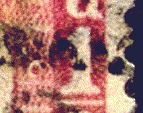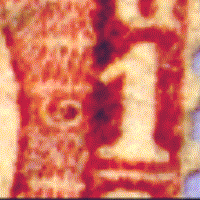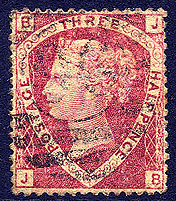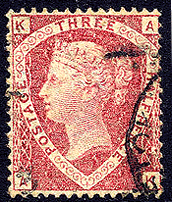|
|
|
The Halfpenny
The Half Penny was introduced as a result of a reduced rate for newspapers and other printed matter. This stamp was issued in sheets of 480 and unlike the other line-engraved issues was perofrated vertically. Mint stamps are not common, and blocks, particularly with marginal imprints are difficult to obtain. Plate 9, of which only 50,000 sheets were printed, is the scarcest plate. This can be compared with the most common plate, Plate 5, of which 533,200 sheets were printed.
|
|
|
 |
|
|
|
|
 |
 |
|
|
|
Note that the top of the numeral 6 faces the "1" of "1/2d" and the
top of the numeral 9 faces the top of the "1" of "1/2d"
Characteristics of TheHalf Penny
| Shades | Rose-red and Rose |
| Watermark | Half Penny covering three stamps in script
Varieties: Inverted; Reversed; Inverted and Reversed; No watermark |
| Imperforate One Side | Exists |
| Imperforate | Exists |
Plates of TheHalf Penny
|
|
|
|
|
|
|
|
|
121,500
|
|
|
|
|
192,500
|
|
|
|
|
264,600
|
|
|
|
|
533,200
|
|
|
|
|
402,100
|
|
|
|
|
*120,000
|
|
|
|
|
*50,000
|
|
|
|
|
386,100
|
|
|
|
|
411,000
|
|
|
|
|
*400,000
|
|
|
|
|
*300,000
|
|
|
|
|
*250,000
|
|
|
|
|
*200,000
|
|
|
|
|
*175,000
|
|
|
|
|
*150,000
|
The Three Halfpence
This denomination was first registered on 22 March 1860 in response
to a proposed change in the postal rates. As the rate
was not approved this stamp, 10,000 sheets printed in Rosy Mauve
(Lilac-rose) , was destroyed. This first issue was watermarked Large
Crown Type I on slightly blued paper. However, some of the
stamps survived, as well as the copies distributed to the postmasters.
10 years later, new postal rates went into effect for printed matter,
including the 1-1/2d. This stamp design was issued again,
but in Rose-red instead of Lilac-rose. Plate 1 was again put
into service, without a plate number shown on the stamp. Plate 2
was defective and not used. Plate 3 was issued with the plate
number as shown below. Stamps issued from Plate 1 are less
common than stamps from Plate 3.
 |
 |
|
|
|
|
|
|
|
 |
|
Large Crown Type I |
Characteristics of TheThree Halfpence
| Shades | Rose-red or Lake-red |
| Varieties | Error of Lettering OP-PC for CP-PC
Watermark Inverted Imerforate Plate 1 and 2 Dr. Perkins Paper Plate 1 |